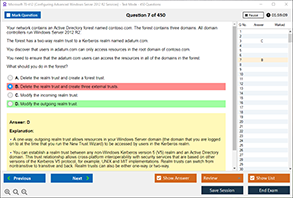Introduction to the Microsoft AZ-700 Exam
In today's rapidly evolving technological landscape, cloud computing has become the backbone of modern IT infrastructure. As organizations increasingly migrate to the cloud, the demand for skilled professionals who can design and implement cloud solutions is skyrocketing. Microsoft Azure, one of the leading cloud platforms, offers a plethora of certifications to validate the expertise of IT professionals. Among these, the Microsoft AZ-700 exam, also known as "Designing and Implementing Microsoft Azure Networking Solutions," stands out as a critical certification for networking specialists.
The AZ-700 exam is designed to test your knowledge and skills in designing, implementing, and managing Azure networking solutions. It covers a wide range of topics, including network virtualization, hybrid networking, routing, and security. Passing this exam not only validates your expertise but also opens up new career opportunities in the cloud networking domain.
In this blog, we will delve into the intricacies of the Microsoft AZ-700 exam, with a particular focus on network virtualization. We will explore Microsoft's network virtualization solutions, understand how Azure Virtual Network (VNet) enables network virtualization, and discuss best practices for implementing network virtualization in Azure. Additionally, we will provide exam preparation tips to help you ace the AZ-700 exam, with a special emphasis on how DumpsBoss can be your ultimate ally in this journey.
Definition of Microsoft AZ-700 Exam
The Microsoft AZ-700 exam is a specialized certification aimed at IT professionals who design and implement networking solutions in Azure. It is part of the Microsoft Certified: Azure Network Engineer Associate certification path. The exam assesses your ability to design, implement, and manage hybrid networking, core networking infrastructure, routing, and security in Azure.
- To pass the AZ-700 exam, you need to demonstrate proficiency in various areas, including:
- Designing and implementing Azure Virtual Networks (VNets)
- Configuring and managing hybrid networking
- Implementing network security
- Monitoring and troubleshooting Azure networking solutions
The exam consists of 40-60 questions, which may include multiple-choice, case studies, and drag-and-drop formats. You have 150 minutes to complete the exam, and a passing score is typically around 700 out of 1000.
Understanding Network Virtualization
Network virtualization is a key concept in cloud computing that allows you to create virtual networks on top of physical network infrastructure. It enables you to abstract the underlying hardware and create multiple virtual networks that can operate independently of each other. This abstraction provides greater flexibility, scalability, and efficiency in managing network resources.
In the context of Azure, network virtualization allows you to create and manage virtual networks that can span across multiple regions and connect to on-premises networks. This capability is crucial for building hybrid cloud environments, where you need to seamlessly integrate on-premises infrastructure with cloud resources.
Microsoft's Network Virtualization Solutions
Microsoft Azure offers a robust set of tools and services to facilitate network virtualization. These solutions are designed to help you create, manage, and secure virtual networks in Azure. Some of the key components of Microsoft's network virtualization solutions include:
- Azure Virtual Network (VNet): Azure VNet is the fundamental building block for network virtualization in Azure. It allows you to create isolated virtual networks that can be customized to meet your specific requirements. You can define IP address ranges, subnets, and network gateways to create a virtual network that mirrors your on-premises network.
- Azure VPN Gateway: Azure VPN Gateway enables you to establish secure, encrypted connections between your on-premises network and Azure VNet. It supports both site-to-site and point-to-site VPN connections, allowing you to extend your on-premises network to the cloud.
- Azure ExpressRoute: Azure ExpressRoute provides a private, dedicated connection between your on-premises network and Azure. It offers higher bandwidth, lower latency, and more reliable connectivity compared to traditional VPN connections.
- Azure Firewall: Azure Firewall is a managed, cloud-based network security service that protects your Azure VNet resources. It provides stateful firewall capabilities, allowing you to control inbound and outbound network traffic based on predefined rules.
- Azure Network Watcher: Azure Network Watcher is a monitoring and diagnostic tool that provides insights into the performance and health of your Azure networking resources. It helps you troubleshoot connectivity issues, monitor network traffic, and optimize network performance.
How Azure Virtual Network (VNet) Enables Network Virtualization
Azure Virtual Network (VNet) is the cornerstone of network virtualization in Azure. It allows you to create a virtual network that is logically isolated from other virtual networks in Azure. This isolation ensures that your network resources are secure and can be customized to meet your specific needs.
Here are some key features of Azure VNet that enable network virtualization:
- IP Address Management: Azure VNet allows you to define custom IP address ranges and subnets for your virtual network. This flexibility enables you to design a network topology that aligns with your organization's requirements.
- Network Segmentation: With Azure VNet, you can create multiple subnets within a single virtual network. This segmentation allows you to isolate different types of resources (e.g., web servers, databases) and apply specific security policies to each subnet.
- Network Connectivity: Azure VNet supports various connectivity options, including VPN Gateway, ExpressRoute, and VNet peering. These options enable you to connect your virtual network to on-premises networks, other virtual networks, and the internet.
- Network Security: Azure VNet provides built-in security features, such as Network Security Groups (NSGs) and Azure Firewall. These features allow you to control inbound and outbound traffic, enforce security policies, and protect your network resources from unauthorized access.
- Scalability and Flexibility: Azure VNet is highly scalable and can accommodate the growing needs of your organization. You can easily add or remove subnets, adjust IP address ranges, and modify network configurations as your requirements evolve.
Best Practices for Implementing Network Virtualization in Azure
Implementing network virtualization in Azure requires careful planning and adherence to best practices. Here are some key recommendations to ensure a successful implementation:
- Plan Your Network Design: Before creating a virtual network, it's essential to plan your network design. Consider factors such as IP address ranges, subnetting, and connectivity requirements. A well-thought-out design will help you avoid potential issues and ensure a smooth implementation.
- Use Network Security Groups (NSGs): NSGs are a critical component of network security in Azure. They allow you to control inbound and outbound traffic to your virtual network resources. Be sure to define NSG rules that align with your security policies and regularly review and update them as needed.
- Implement Azure Firewall: Azure Firewall provides an additional layer of security for your virtual network. It offers advanced threat protection, application-level filtering, and network traffic inspection. Consider implementing Azure Firewall to enhance the security of your network resources.
- Monitor Network Performance: Use Azure Network Watcher to monitor the performance and health of your virtual network. Network Watcher provides valuable insights into network traffic, latency, and connectivity issues. Regularly monitor your network to identify and resolve potential bottlenecks.
- Leverage Hybrid Networking: If your organization has an on-premises network, consider implementing hybrid networking solutions, such as VPN Gateway or ExpressRoute. These solutions enable seamless connectivity between your on-premises network and Azure, allowing you to extend your network to the cloud.
- Optimize Network Routing: Proper routing is essential for efficient network communication. Use Azure Route Tables to define custom routes and control the flow of traffic within your virtual network. Ensure that your routing configuration aligns with your network design and security policies.
- Regularly Update and Patch Resources: Keep your virtual network resources up to date by applying the latest patches and updates. Regular updates help protect your network from vulnerabilities and ensure optimal performance.
Exam Preparation Tips for Microsoft AZ-700
Preparing for the Microsoft AZ-700 exam requires a combination of theoretical knowledge and hands-on experience. Here are some tips to help you succeed:
- Understand the Exam Objectives: Familiarize yourself with the exam objectives and ensure that you have a solid understanding of each topic. The official Microsoft AZ-700 exam page provides a detailed breakdown of the exam objectives.
- Gain Hands-On Experience: Practical experience is crucial for passing the AZ-700 exam. Set up a lab environment in Azure and practice implementing virtual networks, configuring hybrid networking, and managing network security.
- Use Study Guides and Practice Tests: Study guides and practice tests are valuable resources for exam preparation. DumpsBoss offers a comprehensive collection of AZ-700 practice questions and study materials that are designed to help you master the exam content.
- Join Online Communities: Engage with online communities and forums where you can discuss exam topics, ask questions, and share insights with other candidates. Participating in these communities can provide additional support and motivation.
- Review Microsoft Documentation: Microsoft's official documentation is an excellent resource for understanding Azure networking concepts and features. Be sure to review the documentation related to Azure Virtual Network, VPN Gateway, ExpressRoute, and other relevant topics.
- Take Advantage of DumpsBoss: DumpsBoss is a trusted platform that offers high-quality AZ-700 exam dumps, practice tests, and study guides. Their materials are regularly updated to reflect the latest exam content, ensuring that you are well-prepared for the exam.
Conclusion
The Microsoft AZ-700 exam is a challenging but rewarding certification that validates your expertise in designing and implementing Azure networking solutions. Network virtualization is a critical component of the exam, and mastering this topic is essential for success.
By understanding the key concepts of network virtualization, leveraging Microsoft's network virtualization solutions, and following best practices, you can build a strong foundation for the AZ-700 exam. Additionally, with the right preparation strategies and resources, such as those offered by DumpsBoss, you can confidently approach the exam and achieve your certification goals.
Remember, passing the AZ-700 exam is not just about earning a certification; it's about gaining the knowledge and skills to design and implement robust, secure, and scalable networking solutions in Azure. So, take the first step towards your certification journey today, and let DumpsBoss be your guide to success.
Special Discount: Offer Valid For Limited Time “AZ-700 Exam” Order Now!
Sample Questions for Microsoft AZ-700 Dumps
Actual exam question from Microsoft AZ-700 Exam.
Which of the following is a network virtualization solution provided by Microsoft?
A) VMware NSX
B) Hyper-V Network Virtualization
C) Cisco ACI
D) OpenStack Neutron


